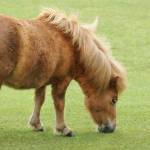Feeding Frequency: Does It Affect Digestion in Ponies?

The horse is a grazing animal by nature, with free-ranging horses spending up to 75% of their time grazing. However, modern management requires many horses to live in confinement. Because of increased nutrient requirements due to growth, work, gestation, or lactation, these horses are often fed a high concentrate diet containing large amounts of starch.
Source of starch and processing affect feed digestibility, and intake levels above 0.4% of body weight decrease starch digestion in the foregut and increase digestion in the hindgut. Increased rate of passage decreases digestion prececally and also decreases absorption of nutrients. Other physiological responses to a large meal include decreased plasma volume and increased plasma protein.
Research conducted at the University of Kentucky was designed to test the hypothesis that increased frequency of feeding would improve nutrient digestion. Four mature Shetland ponies were used for the study. Each horse was fed a complete feed containing forage and grain at 2% of body weight. The ration was fed in 2, 4, 8, or 16 meals per day in a 4 x 4 Latin square design utilizing a 10-day period and a 3-day total fecal collection. Starch, crude protein (CP), dry matter (DM), crude fat (CF), acid detergent fiber (ADF), neutral detergent fiber (NDF), and ash digestibilities were determined. Plasma protein and hematocrit were also measured over a 12-hour period to evaluate changes in plasma volume.
Results showed that feeding frequency did not affect digestion of starch, CP, DM, CF, ADF, or ash. Feeding 2 or 16 meals/d increased digestion of NDF (P<0.05). Plasma protein levels increased 30 minutes after the 9 a.m. feeding when ponies consumed 2 meals per day. At 10 a.m., plasma protein decreased when ponies fed 4 meals per day were compared to ponies eating 2 or 8 meals per day. The treatment using 16 meals per day was not different from the 4 meals per day treatment.
These results do not support the hypothesis that increased frequency of feeding is associated with an increase in digestibility. The results may be due to the diet, as it was low in fiber. However, the large fluctuation in plasma protein concentration in this study is an indication that water balance is affected by large, infrequent meal feeding. Therefore, the present results suggest that increasing feeding frequency may regulate plasma volume which could be beneficial to stabled horses.
This paper can be found in Advances in Equine Nutrition. The author has been a frequent contributor to the Advances in Equine Nutrition series by virtue of her willingness to share the results of studies she and her students conduct at the University of Kentucky, where she is a professor.








